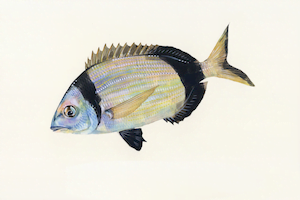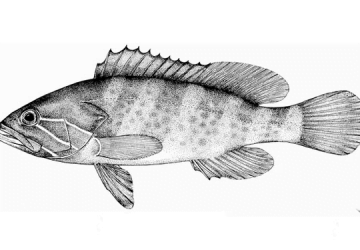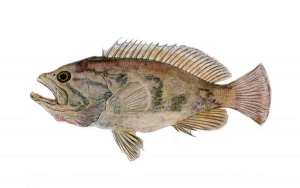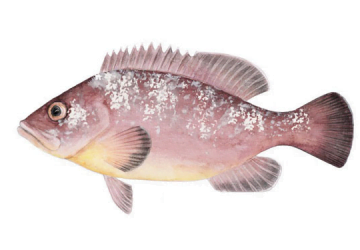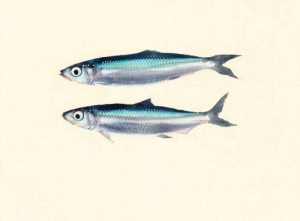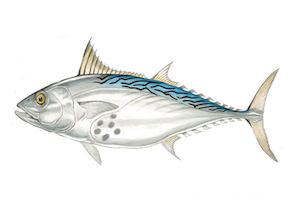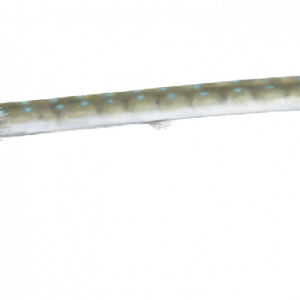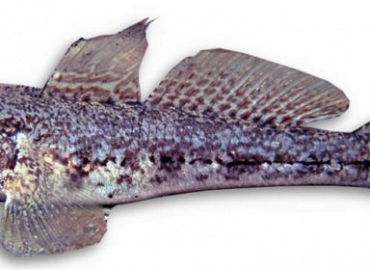Myliobatis Aquila
– Common Eagle Ray –
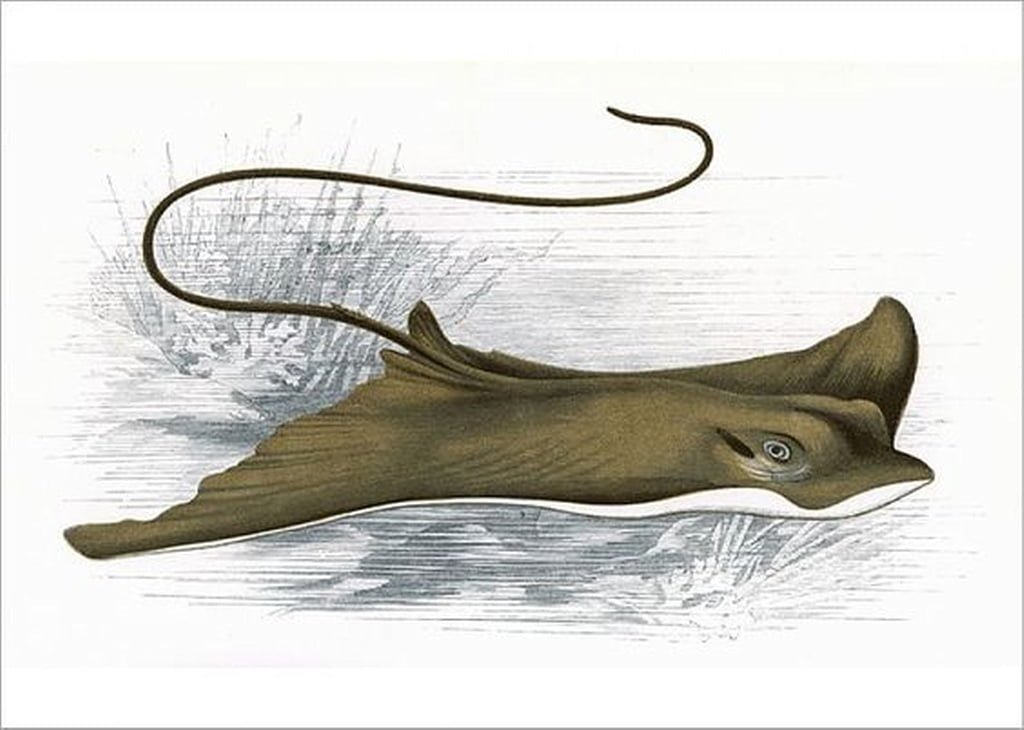
| Conservation status |
|---|
 Data Deficient (IUCN 3.1)[1] |
| Scientific classification |
Myliobatis aquila Linnaeus, 1758
| Kingdom: | Animalia |
| Phylum: | Chordata |
| Class: | Chondrichthyes |
| Order: | Myliobatiformes |
| Family: | Myliobatidae |
| Genus: | Myliobatis |
| Species: | M. aquila |
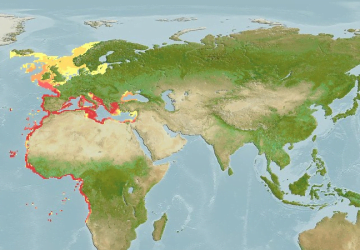
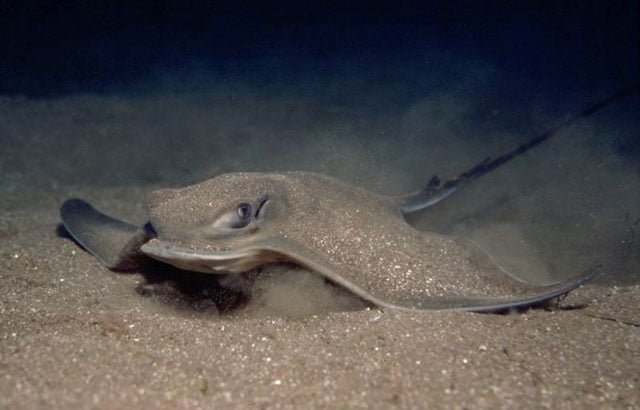
The common eagle ray (Myliobatis aquila) is a species of fish in the family Myliobatidae. It inhabits the eastern Atlantic Ocean (North Sea to South Africa), the Mediterranean Sea and the south-western Indian Ocean.[1]
Description
The common eagle ray reaches up to 183 cm (6.0 ft) in total length[2] and has a disc width up to 80 cm (2.6 ft).[3] It has a rhomboidal disc with a pair of large, triangular pectoral fins projecting on either side, and a single dorsal fin. The snout is rounded and the tail slender, with a large spine at its base but no tail fin. The dorsal surface is brown or black while the ventral surface is white.[2]
Myliobatis aquila is a ray easily identifiable by its prominent muzzle with rounded rostrum which earned it its eagle name. Its head, which laterally bears a pair of prominent eyes and, behind, a pair of large spiracles *, is raised above the rest of the body. The mouth and the five pairs of gill slits are ventral. The dorsal side is dark (brown to black) , the ventral side is white . It has two pointed pectoral fins , commonly called “wings” and which, seen from above or below, give it a diamond shape.. It also features a pair of quadrangular pelvic fins, as well as a short, receding dorsal fin, located at the base of the tail. This, in the shape of a whip , is very thin and is on average twice as long as the body . It is equipped with one or with two venomous spines implanted dorsally behind the fin.
Distribution and Habitat
Biotope
The eagle ray is bentho-pelagic *, it swims preferentially near the bottom. Its bathymetric distribution extends from the surface to a depth of about 300 meters. Even if it can be found in open water and near the surface, it mainly likes the proximity of the coasts on sandy bottoms.
It occurs both close to the shore and further out, at depths down to about 800 m (2,600 ft), but much of its time is spent in very shallow water at less than 50 m (160 ft).[1]
This ray occurs in the eastern Atlantic Ocean from the United Kingdom southward to South Africa, including the North Sea and the Mediterranean Sea. It also occurs in the Indian Ocean, ranging from Kenya to South Africa.
Similar Species
In Europe, confusion is unlikely.
Let us quote the cow-eagle, Pteromylaeus bovinus (E. Geoffroy Saint-Hilaire, 1817), present in the Mediterranean (and on the eastern Atlantic coast from Portugal to South Africa), which is distinguished from the eagle ray by one side dorsal marbled brown.
Associated Life
During the hunting season, all kinds of “picnic” fish closely follow the eagle ray and take advantage of its movement to catch small prey exposed by swimming above the sand.
Various Biology
This ray is frequently encountered in groups, in bays, lagoons and estuaries. His skin is smooth and very viscous, with an abundant secretion of mucus. Its weight can reach fifteen kilograms.
Ecology
The species largely feeds on crustaceans and bivalve molluscs that it excavates from the seabed. Other items in its diet include polychaete worms, gastropod molluscs, sea pens and small fish. Instead of having pointed teeth, it has flattened hexagonal bars and plates arranged in a mosaic pattern on its jaws; with these, it crushes the shells of its prey.[4]
Reproduction is oviviviparous. A clutch of three to seven young develop inside the mother, receiving nourishment at first from their egg yolks, but later from fluids secreted by their mother into her uterus.[2]
Alimentation
The eagle ray has a carnivorous diet: it feeds on crustaceans and molluscs (gastropods, bivalves, cephalopods) that it captures in the sand. It is able to detect the vibrations of its prey in the sediment and only has to extract them by using its fins and by projecting on the sand a jet of water directed through its mouth.
Occasionally, it can capture worms (polychaetes, nemertes …) and also fish.
The mouth of the ray is equipped with one to seven rows of joined teeth forming a dental plaque, which allow to efficiently crush the shells and shells.
Reproduction
Reproduction is sexual. It takes place in shallow water and near the bottom. The sexual maturity of males is reached for a size of 40 cm and that of females 60 cm. During mating, the male keeps his partner motionless by biting a pectoral. Belly to stomach, it introduces one of its pterygopods * into the female’s genital tract. This mating is very short (30 seconds to 2 minutes), the female being able to mate successively with several males.
The species is ovoviviparous *: at the end of spring or at the beginning of summer, the females give birth to 3 to 7 perfectly formed young after a gestation of 6 to 8 months.
Status
The taxonomic position of this fish is unclear as populations in the Mediterranean Sea may be a different species from those in the southeastern Atlantic. In the Gulf of Lion in the northwestern Mediterranean Sea, populations declined in the 1970s, and there and elsewhere in the Mediterranean, the fish is under threat from intensive fishing. Along the coast of West Africa it is also the subject of artisanal fishing activities but these are less intensive and populations may be steady. The taxonomic uncertainty and the lack of data on populations of this fish has caused the International Union for Conservation of Nature to rate it as “data deficient“.[1]
Further Information
Watch out for pricks which can inflict severe and painful injuries! The eagle ray is not dangerous, will never use it against the diver, but the handling of these pricks is very risky. Better to be careful and stay away from the stingray …
Because of its tail and stingers, this species is often trapped in fishing nets. Ascent, it is then generally released.
The pectoral fins of sea eagles are frequently sold on the shelves of the Adriatic and Maghreb where they are consumed.
This ray adapts very well to captive life and is frequently featured in public aquariums.
The encounter with an eagle ray is particularly appreciated by divers, especially because of its fascinating swimming. Like an underwater bird, she uses her “wings” to move and appears to fly gracefully.
















